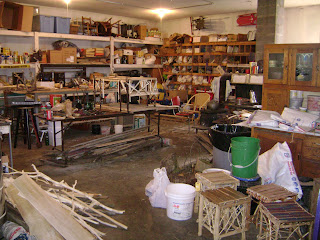Stool Number 20 is the first one I've done completely in a city apartment. It's made of what we call popple, what the hoity toities refer to as "
quaking aspen".
The wood came from a huge tree that was too near a friend's house out in the country, and leaning in the direction of the house. By use of a rope tied high up the tree, a large pulley tied to another tree, a
John Deere A tractor, and skillful notching on my friend's part, the tree was brought down exactly as planned -- right between two other trees that were to be saved, and at just the right angle that it didn't go out over the road.
I was there to shout advice, help trim branches and load the trailer, and as I did so, I asked for a few pieces of wood for myself.
The picture above is of my grandson posing in my new work-space, in the living room of the apartment.
The seat is made of a larger piece of popple, split with a hatchet to make rough boards, then sanded.
I had a heck of a time attaching the stool together without making hammering noises in the apartment building. I got it done, though, without any major complaints. I went downstairs a couple of times and used the concrete floor in the back entrance of the building, so I wouldn't be pounding on the ceiling of the apartment of the downstairs neighbors.

The picture to the right is of all the wood and sticks I used to have stored in my former work-place. I had all the wood there sorted by variety, but in moving it to the neighbors' place, then piling it inside an old trailer, it got all mixed up, and is now pretty much a jumbled mess. I'm still glad to have it, though it's about 20 miles from here, and not quite as convenient as it used to be.
What's left of the popple is to the right of the picture. For the next stool I make out of popple, I plan to cut one of the large pieces to about 17 inches, then split it with the hatchet for legs, seat, and bracing. The grain is quite straight on the trunk of this old tree.
This stool, however, except for the seat, was made from the branches of the tree, which were not straight, and which split into some really interesting shapes.
As all the other stools, the joints are nailed, then tied with strong wire, so they won't work loose as traditional doweled and glued joints eventually always do. These stools are both light in weight, and exceptionally strong.
This finished stool pictured in two pics below, is for sale for $65. (Sorry, this stool is no longer available for sale.) For further information, please contact me through the comments section of this blog, or by email at lewagner2002@yahoo.com.
For general information on these stools and more pictures, please see older posts, and the
Introduction to this blog.


.JPG)
.JPG)







































